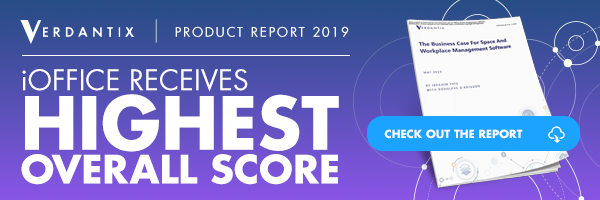The Top 3 Business Cases for A Workplace Management System


More than a third of corporate real estate and facilities executives are considering the purchase of software to improve real estate and building management, according to a 2018 global survey by independent analyst firm Verdantix.
Of those, 20% are considering a workplace management system, also known as an IWMS.
The report, The Business Case for An Integrated Workplace Management System, outlines the three most important business priorities driving executives to make this purchase. Leading with these objectives can help them justify the investment to their leadership teams. Here’s a closer look at each one.
Top 3 drivers for a workplace management system
1. Driving strategic decision making
Many large organizations today use a wide range of workplace software systems to oversee real estate, assets and processes. Yet more than a third of corporate real estate managers said having a single workplace management system to handle it all was an important priority, according to the Verdantix survey.
Combining all these functions into an integrated workplace management system gives real estate and facilities leaders a single source of truth when it comes to data. They can easily see the costs and utilization of each property and how it compares to others in their portfolio. This enables them to make more informed decisions related to their real estate and assets.
It also gives each department the data they need for smarter, faster decision-making. For instance, facilities managers can plan office moves in a fraction of the time. And the HR department can easily see how many desks are available on a particular floor when they make decisions about where to place new hires.
2. Reducing Costs And Improving Operational Efficiency
Moving to a single workplace management system also leads to a significant reduction in IT costs. Large organizations with dozens of disparate systems typically need a large IT infrastructure and team to manage them all. And managing updates for each system can be a substantial cost burden, since most legacy systems were built as on-premise or hosted solutions.
Our customers who have worked with other legacy solutions have shared the cost of IWMS software updates can range from $50,000 to over $1 million, depending on the complexity of the system. It can also take up to 18 months to complete the update—not including the time it takes to secure budget approval for it. And that’s just one system.
The Verdantix report gives the example of one smartphone company that was using 65 different software systems to manage its facilities worldwide.
Streamlining these systems into one SaaS-based workplace management system eliminates the need for expensive and time-consuming updates.
3. Improving The Occupant Experience
There is growing awareness of smart, connected buildings and a desire to use technology not only to improve energy efficiency and reduce costs, but to create a better environment for occupants.
With the rise of coworking spaces and alternative work arrangements, both tenants and employees expect more from their workplace. While they can work virtually anywhere with an internet connection, they still need to be able to find their colleagues, find their way around and reserve rooms so they can collaborate. They want a comfortable environment that’s tailored to their preferences. And they want self-serve access to equipment and amenities.
As a result, real estate and facilities management executives are looking for an integrated workplace management system with these added capabilities. In a 2018 CBRE survey, 59% said they plan to add mobile apps that “enhance the employee experience by helping them to navigate the built environment more efficiently.”
Find out how pharmaceutical company Vertex is using mobile technology to improve the tenant experience and manage chargebacks.
Justifying a workplace management system
Investing in a workplace management system can result in significant savings, with a payback period of as little as six months. However, it’s still a sizeable investment. The average cost of an IWMS can range from $50,000 to $800,000, according to Verdantix. Many are on-premise, legacy systems that require a lot of IT support, which likely factors into the costs on the higher end of the spectrum. (By contrast, the costs of SaaS-based IWMS solutions tend to be on the lower end of the spectrum.)
To secure budget approval, CRE and FM executives need to develop a robust business case that outlines the anticipated savings. Here are four critical points to make:
- Speak to the immediate IT savings of consolidating multiple systems into one.
- Demonstrate the impact of improving space utilization, considering the average unused workstation can cost an organization $18,000 per year.
- Estimate the energy management and maintenance savings you can expect to see with a combination of software and IoT sensors that measure occupancy.
- Show how improving the occupant or employee experience will lead to improved productivity and profitability.
Now that you know the three most pressing business arguments for investing in a workplace management system, how do you choose the right one? The latest Verdantix report evaluates 15 workplace management solutions and eight specialty vendors providing workplace services.
Download the report today to see how each compares.
